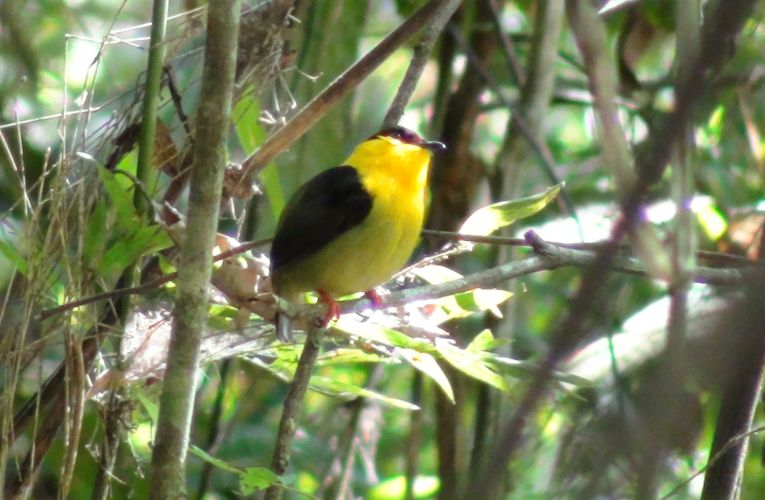Manakins are birds that are choosy about their mates. The display the lady likes is critically appreciated on the lek, or display area. The males need lots of energy, but in tropical conditions, it's rather like the World Cup worries in the Amazon or Qatar! Manacus vitellinus is the golden-collared manakin, similar to our white-collared species here. In Panama, it takes 7 months of acrobatics to complete their breeding season, though I doubt if males perform for the whole season.
The heart rate of a performing male must be regulated in the heat, using a slow pace of life. The metabolism has to be suited to a low daily energy expenditure, referred to a as DEE and this as confirmed by a 5 minute per day activity "rota." This confirmed that DEE is 39 kJ per day, similar to that of other lowland birds. Only 1.2% of the daily total is utilised by display, meaning they can indeed last for months. Lucky girls!
The exaggerated and elaborate sexual display in the case of this manakin involves just a couple of individual males, who dominate the lek with specialised "jump-snap" displays between young sapling trees! The snap is a crack of the wings above the back, as they rapidly meet together in wing-snaps or high frequency roll-snaps.
When not indulging in display or actual procreation, the birds show a true character, typical of lowland tropical forest birds. Only 1 or 2 eggs are laid, with a 14 year life-span recorded for some wild individuals. "Rapid metabolisers" such as the speeding cheetah expend 50 X the energy of their normal resting metabolic rate.
So how much energy can be measured in a wild(ly) displaying bird? Certainly a similar amount to that of the racing feline, using special physiological and behavioural adaptation. The cheetahs cheated because they were captive animals, but the latest miniature transmitter scan record wild heart-rates (equivalent to energy expenditure) to give an estimate of metabolic rate. This is the only available telemetric technique to give second-by second records of energy use.
Day and night records were recorded in 8 male birds from 5 different leks, with special reference to the display of course. The spotted ant bird, Hylophylax naevioides was compared to the manikin in order to obtain some idea of energetics in other similar tropical, non-lekking birds.
The transmitters were attached in such a way that after 14 days, they fell off, meaning the animals had to be captured only once. The heart rates were simply recorded as sound files every 10 minutes, for 30 seconds.
A low DEE was recorded, more or less the same as the ant-bird mentioned, despite the high-cost display activity in manakins. Daily courtship results in no high energy costs overall, though the time on the lek is obviously, very powerful display to attract the females. These brief spells demanded 9X the minimum metabolic rate and 3X the DEE. The males may have used anaerobic energy production, though that is likely to have be limited. The heart rate decreases immediately after courtship, so no oxygen deficit can have arisen. Aerobic respiration was obviously the energy source.
Many other birds display for much longer in temperate climates, but humans should be the first to consider climatic conditions, given their African ancestry. The noise of thee males performing attracts many females and gains mating success for both partners, but minimal energy is involved, with a maximum of 55% of the males' daily energy used up in a maximum of 140 displays. (That's for a 9.5 second performance, on average.) In other lekking birds such as sage grouse, they compromise with a shorter 1 or 2 month courtship period. Other manikin species may prove to be different, but it seems that the slow pace of life strategy for their metabolism suits many tropical birds, and maybe even mammals and heaven forbid, humans!
J. Barske and her colleagues from UCLA, the University of Ferrara, the Max Planck Institute for Ornithology, Konstaanz University and Instituto Conmemorativo Gorgas de Estudios de la Salud y Instituto Smithsonian de Investigaciones Tropicales, wrote their paper on "Energetics of the acrobatic courtship in male golden-collared manakins" in the Proceedings of the Royal Society B.










